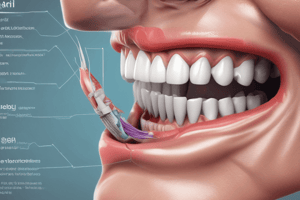Podcast
Questions and Answers
What characterizes the occlusal surface of permanent posterior teeth?
What characterizes the occlusal surface of permanent posterior teeth?
- It has a flat surface bordered by lateral ridges.
- It has a smooth surface without any ridges.
- It includes only one cusp with no inclined planes.
- It features raised marginal ridges on the distal and mesial surfaces. (correct)
What is the function of triangular ridges on posterior teeth?
What is the function of triangular ridges on posterior teeth?
- To create additional cusps on the occlusal table.
- To determine the height of the occlusal surface.
- To connect the cusps to the marginal ridges.
- To descend from the cusp tips toward the central part of the occlusal table. (correct)
How are the inclined cuspal planes named?
How are the inclined cuspal planes named?
- By their color and size.
- Based on the angles of the cusp ridges.
- According to the number of cusps present.
- By combining the names of the cusp ridges they lie between. (correct)
Where is the central fossa located on posterior teeth?
Where is the central fossa located on posterior teeth?
What describes occlusal pits found on permanent posteriors?
What describes occlusal pits found on permanent posteriors?
Which feature is described as a collective term for two triangular ridges crossing the occlusal table?
Which feature is described as a collective term for two triangular ridges crossing the occlusal table?
What type of groove is also referred to as primary grooves on the occlusal table of posterior teeth?
What type of groove is also referred to as primary grooves on the occlusal table of posterior teeth?
How many cusps are typically found on the occlusal surface of permanent posterior teeth?
How many cusps are typically found on the occlusal surface of permanent posterior teeth?
What is the most prominent developmental groove on posterior teeth?
What is the most prominent developmental groove on posterior teeth?
What is the main function of the marginal grooves on posterior teeth?
What is the main function of the marginal grooves on posterior teeth?
Where is the height of contour for the buccal surface of posterior crowns typically found?
Where is the height of contour for the buccal surface of posterior crowns typically found?
How does the CEJ curvature of posterior teeth compare to that of anterior teeth?
How does the CEJ curvature of posterior teeth compare to that of anterior teeth?
What increases the risk of caries in posterior teeth?
What increases the risk of caries in posterior teeth?
What are the root branches of multirooted posterior teeth referred to as?
What are the root branches of multirooted posterior teeth referred to as?
What characterizes supplemental grooves on posterior teeth?
What characterizes supplemental grooves on posterior teeth?
What is the result of root fusion in a bifurcated posterior tooth?
What is the result of root fusion in a bifurcated posterior tooth?
Flashcards are hidden until you start studying
Study Notes
Permanent Posterior Teeth
- Permanent posterior teeth include premolars and molars.
- The occlusal surface of posterior teeth acts as the masticatory surface.
- The occlusal surface is bordered by the marginal ridges, located on the distal and mesial surfaces.
- The occlusal surface has multiple cusps and cusp ridges.
- Cusp ridges descend from the cusp tip and form an inclination plane
- The occlusal surface forms a table bordered by the marginal ridges.
- Triangular ridges descend from the cusp to the center of the occlusal table.
- A transverse ridge is formed when two triangular ridges meet, creating a cross from the labial to lingual side.
- The occlusal table has depressions called fossae - central fossa located at the meeting point of the grooves and triangular fossae, which are associated with the triangular grooves
- Occlusal pits are found at the deepest part of the fossa.
- The occlusal table has developmental grooves, which mark the junction of the lobes.
- Developmental grooves are deep V shaped depressions.
- The central groove is the main developmental groove and separates the occlusal table.
- Marginal grooves cross the marginal ridges, allowing food to escape.
- Triangular grooves are between the marginal ridge and triangular cusp ridges.
- Supplemental grooves are shallower and less regular than developmental grooves.
- Most posteriors are wider LL than MD, except mandibular molars.
- The contact area is wider and usually located buccally.
- The CEJ curvature is less pronounced, often straight on posterior teeth.
Root Structures
- Posterior teeth have a single root trunk at the base of the crown.
- The root trunk can bifurcate (two roots) or trifurcate (three roots).
- Some bifurcated teeth can have fused roots.
- Furcation is the area between two or more root branches, before they divide from the root trunk.
- Crotches are the furcation spaces between roots.
Clinical Considerations
- The complex pit and groove pattern increases the risk of caries.
- The structure of enamel in pits and grooves makes posterior teeth more susceptible to caries.
- Deep pit and groove patterns may benefit from the application of dental sealants.
Studying That Suits You
Use AI to generate personalized quizzes and flashcards to suit your learning preferences.




